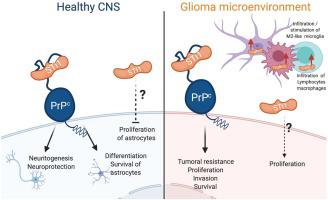Cytokine & Growth Factor Reviews ( IF 9.3 ) Pub Date : 2020-06-08 , DOI: 10.1016/j.cytogfr.2020.06.003 Anna Carolina Carvalho da Fonseca 1 , Diana Matias 2 , Luiz Henrique Medeiros Geraldo 3 , Felipe Saceanu Leser 4 , Iohana Pagnoncelli 4 , Celina Garcia 4 , Rackele Ferreira do Amaral 4 , Barbara Gomes da Rosa 4 , Izabella Grimaldi 4 , Eduardo Sabino de Camargo Magalhães 5 , Valentín Cóppola-Segovia 6 , Evellyn Mayla de Azevedo 6 , Silvio Marques Zanata 6 , Flavia Regina Souza Lima 4

|
Stress inducible protein 1 (STI1) is a co-chaperone acting with Hsp70 and Hsp90 for the correct client proteins’ folding and therefore for the maintenance of cellular homeostasis. Besides being expressed in the cytosol, STI1 can also be found both in the cell membrane and the extracellular medium playing several relevant roles in the central nervous system (CNS) and tumor microenvironment. During CNS development, in association with cellular prion protein (PrPc), STI1 regulates crucial events such as neuroprotection, neuritogenesis, astrocyte differentiation and survival. In cancer, STI1 is involved with tumor growth and invasion, is undoubtedly a pro-tumor factor, being considered as a biomarker and possibly therapeutic target for several malignancies. In this review, we discuss current knowledge and new findings on STI1 function as well as its role in tissue homeostasis, CNS and tumor progression.
中文翻译:

共伴侣应激诱导蛋白1的多种功能
应激诱导蛋白 1 (STI1) 是一种与 Hsp70 和 Hsp90 一起作用的共分子伴侣,用于正确的客户蛋白折叠,因此用于维持细胞稳态。除了在细胞质中表达外,STI1 还可以在细胞膜和细胞外介质中找到,在中枢神经系统 (CNS) 和肿瘤微环境中发挥多种相关作用。在 CNS 发育过程中,与细胞朊病毒蛋白 (PrP c),STI1 调节关键事件,如神经保护、神经发生、星形胶质细胞分化和存活。在癌症中,STI1参与肿瘤的生长和侵袭,无疑是一种促肿瘤因子,被认为是多种恶性肿瘤的生物标志物和可能的治疗靶点。在这篇综述中,我们讨论了 STI1 功能及其在组织稳态、中枢神经系统和肿瘤进展中的作用的当前知识和新发现。











































 京公网安备 11010802027423号
京公网安备 11010802027423号